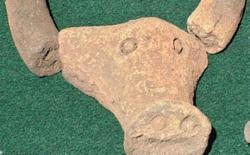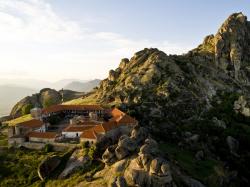INSTITUT SUPERIEUR D'ANTHROPOLOGIE
INSTITUTE OF ANTHROPOLOGY
ONLINE COURSES / COURS A DISTANCE
OPEN COURSE : FEBRUARY 2013
HRM 104 : INTRODUCTION TO INTANGIBLE CULTURAL HERITAGE
REGISTER NOW
INDE –  Nilgiris - Observing that the Nilgiris has always provided abundant material for pre-historic research and kept alive interest in the megalithic era in South India, a senior researcher called for the protection of ancient burial sites existing in the district. M Ravichandran, a senior artist with the Government Museum and Art Gallery in Ooty, explained that four burial sites had been discovered in the Nilgiris since the 19th Century at Stone Circle, Cairn Circle, Dolmen and Draw Well Cairn. He had recently collected fragments of a miniature buffalo-head made of unique stones from an ancient burial site of the Toda tribal community at School Mund on the outskirts of the hill station. He said, “During my visit to the ancient burial site of Draw Well Cairn near School Mund, I came across a number of terracotta figurine relics. These could be termed ‘grave goods’. The figures include an elephant trunk, buffalo heads, horns, punch-marked animal bodies and some pot shreds. J W Breeks was the first British archaeologist to excavate artifacts from megalithic burial sites of the Nilgiris in 1873, which have been kept at museums in London, Berlin and Madras. Actually, the pre-historic monuments have been vandalised by natural calamities and human interruption. Hence, protection of ancient burial sites will be much useful for those interested in research and those visiting the Nilgiris.” According to him, the custom of erecting tombs to pay homage to departed ancestors prevailed among the megalithic people in different times in most parts of the world, starting from the Neolithic era. Different theories existed among scholars regarding the origin and diffusion of the megalithic people. Indian megalithic culture dated back to 1,000 BC and the heritage of the Nilgiris could be traced from the pre-historic period, that is 2,000 years ago.
Nilgiris - Observing that the Nilgiris has always provided abundant material for pre-historic research and kept alive interest in the megalithic era in South India, a senior researcher called for the protection of ancient burial sites existing in the district. M Ravichandran, a senior artist with the Government Museum and Art Gallery in Ooty, explained that four burial sites had been discovered in the Nilgiris since the 19th Century at Stone Circle, Cairn Circle, Dolmen and Draw Well Cairn. He had recently collected fragments of a miniature buffalo-head made of unique stones from an ancient burial site of the Toda tribal community at School Mund on the outskirts of the hill station. He said, “During my visit to the ancient burial site of Draw Well Cairn near School Mund, I came across a number of terracotta figurine relics. These could be termed ‘grave goods’. The figures include an elephant trunk, buffalo heads, horns, punch-marked animal bodies and some pot shreds. J W Breeks was the first British archaeologist to excavate artifacts from megalithic burial sites of the Nilgiris in 1873, which have been kept at museums in London, Berlin and Madras. Actually, the pre-historic monuments have been vandalised by natural calamities and human interruption. Hence, protection of ancient burial sites will be much useful for those interested in research and those visiting the Nilgiris.” According to him, the custom of erecting tombs to pay homage to departed ancestors prevailed among the megalithic people in different times in most parts of the world, starting from the Neolithic era. Different theories existed among scholars regarding the origin and diffusion of the megalithic people. Indian megalithic culture dated back to 1,000 BC and the heritage of the Nilgiris could be traced from the pre-historic period, that is 2,000 years ago.
http://newindianexpress.com/states/tamil_nadu/article1448608.ece
GRECE –  Platania /Aghia Paraskevi - It is one of the most important prehistoric sites of Central Greece with uninterrupted habitation from the Early Neolithic period until the Late Bronze Age. Currently, excavation works focus on unearthing a flourishing settlement’s remains, dating to the Middle-Helladic period (2000-1600 BC). Archaeologists have already brought to light a big number of apsidal and rectilinear buildings on both sides of the roads, impressively well-preserved, regarding their stone foundations and their household equipment, which was preserved in situ underneath the layer of the fallen brick superstructure. Big storage vessels as well as smaller ones for everyday use, stone and bone tools are some of the findings that indicate everyday activities of the inhabitants and their trade and cultural encounters with nearby and distant areas of the Greek mainland and the islands. These contacts were helped by the location of the settlement, which in that period was near the sea, as the palaeo-geographic studies of the Aristotle University of Thessaloniki showed.
Platania /Aghia Paraskevi - It is one of the most important prehistoric sites of Central Greece with uninterrupted habitation from the Early Neolithic period until the Late Bronze Age. Currently, excavation works focus on unearthing a flourishing settlement’s remains, dating to the Middle-Helladic period (2000-1600 BC). Archaeologists have already brought to light a big number of apsidal and rectilinear buildings on both sides of the roads, impressively well-preserved, regarding their stone foundations and their household equipment, which was preserved in situ underneath the layer of the fallen brick superstructure. Big storage vessels as well as smaller ones for everyday use, stone and bone tools are some of the findings that indicate everyday activities of the inhabitants and their trade and cultural encounters with nearby and distant areas of the Greek mainland and the islands. These contacts were helped by the location of the settlement, which in that period was near the sea, as the palaeo-geographic studies of the Aristotle University of Thessaloniki showed.
http://www.archaiologia.gr/en/blog/2013/02/05/the-prehistoric-platania-site-of-aghia-paraskevi/
USA – Savannah - Crouched inside a square, 3-foot-deep excavation hole, Blake Ayala carefully scraped a sample of red-brown dirt into a small baggie. Through a partnership between the university and the city of Savannah, Ayala is leading the archaeological survey of the four-vault structure beneath Bay Street, known as the Cluskey Embankment Stores. "The hope is that we're going to be able to learn from this project what these areas were used for," Ayala said. "There isn't a lot known about what they were used for early on, so hopefully we'll help solve that mystery." Many believe the vaults were used to house slaves before they were auctioned, said Luciana Spracher, director of the city's research library and municipal archives, but due to a lack of historical documentation that theory has never been proven. What is known, she said, is the structures were designed by architect Charles B. Cluskey as part of a city project to prevent erosion in the area and to raise the public walkway above it to be even with Bay Street. Cluskey broke ground on the project in 1840, and it was completed by William S. Walker in 1842. "Over the years the question of what these vaults were used for has been very interesting," she said. "We know they were used for storage, and we know for as many as 100 years — up until this last November — we've been using them for parking. Through this partnership with Georgia Southern we're going to really learn a lot about their history, which is a good thing for Savannah."
http://ap.onlineathens.com/pstories/state/ga/20130204/1095806021.shtml
MACEDOINE – 
 Treskavec - A blaze on Monday at the Treskavec monastery near Prilep burned down the monks' quarters - though firefighters and volunteers saved the church and its ancient frescoes. The monastery is near the rocky hilltop called Zlatovrv, in a serene surrounding some ten kilometres from the central town of Prilep, affording a magnificent view of the Pelagonia valley. It is believed to date from the 12th and 13th century. It is also home to an extensive collection of Byzantine frescoes, some considered masterpieces of Orthodox Christian art. It is frequently visited by believers and tourists.
Treskavec - A blaze on Monday at the Treskavec monastery near Prilep burned down the monks' quarters - though firefighters and volunteers saved the church and its ancient frescoes. The monastery is near the rocky hilltop called Zlatovrv, in a serene surrounding some ten kilometres from the central town of Prilep, affording a magnificent view of the Pelagonia valley. It is believed to date from the 12th and 13th century. It is also home to an extensive collection of Byzantine frescoes, some considered masterpieces of Orthodox Christian art. It is frequently visited by believers and tourists.
http://www.balkaninsight.com/en/article/valuable-church-survives-monastery-fire-in-macedonia
TURQUIE –  Istanbul - A Turkish parliamentary commission is considering an application by citizens to turn the Hagia Sophia in Istanbul into a mosque. The Hagia Sophia Museum was first dedicated as an Orthodox patriarchal basilica in 360. Until the year of 1453 it served as the Greek Patriarchal cathedral of Constantinople. Following the city’s conquest by the Ottoman Empire, the building turned into a mosque in 1453 and remained so until 1931, when it was closed to the public for four years. It was reopened by the republican authorities in 1935 as a museum.
Istanbul - A Turkish parliamentary commission is considering an application by citizens to turn the Hagia Sophia in Istanbul into a mosque. The Hagia Sophia Museum was first dedicated as an Orthodox patriarchal basilica in 360. Until the year of 1453 it served as the Greek Patriarchal cathedral of Constantinople. Following the city’s conquest by the Ottoman Empire, the building turned into a mosque in 1453 and remained so until 1931, when it was closed to the public for four years. It was reopened by the republican authorities in 1935 as a museum.
http://www.hurriyetdailynews.com/
TURQUIE –  Side - The Ministry of Culture and Tourism has launched a restoration project for the historic Temple of Apollo in the ancient city of Side, located on the southern Mediterranean coast of Turkey. As the 2,000 year-old Temple of Apollo is situated on the coast, its columns have been badly affected by moisture and saltwater, which is causing erosion. Speaking to Today's Zaman regarding to the ongoing restoration at the temple, Deputy Culture and Tourism Minister Abdurrahman Arıcı said they are working to preserve the temple. Stating that they plan to prevent corrosion to the temple's columns, Arıcı further added that the historic temple remains standing despite its age thanks to such regular protective projects.
Side - The Ministry of Culture and Tourism has launched a restoration project for the historic Temple of Apollo in the ancient city of Side, located on the southern Mediterranean coast of Turkey. As the 2,000 year-old Temple of Apollo is situated on the coast, its columns have been badly affected by moisture and saltwater, which is causing erosion. Speaking to Today's Zaman regarding to the ongoing restoration at the temple, Deputy Culture and Tourism Minister Abdurrahman Arıcı said they are working to preserve the temple. Stating that they plan to prevent corrosion to the temple's columns, Arıcı further added that the historic temple remains standing despite its age thanks to such regular protective projects.
http://www.todayszaman.com/news-305986-ancient-roman-temple-of-apollo-in-side-under-restoration.html